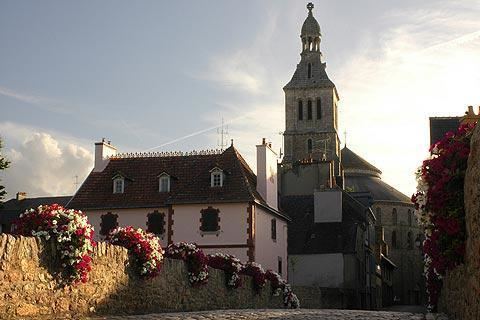Intercommunality Pays de Quimperlé Area 31.73 km² | Canton Quimperlé Population (2013) 11,978 Local time Tuesday 5:06 PM | |
 | ||
Weather 10°C, Wind SW at 21 km/h, 55% Humidity | ||
Quimperlé (Breton: Kemperle) is a commune in the Finistère department of Brittany in northwestern France.
Contents
Map of 29300 Quimperl%C3%A9, France
Geography
Quimperlé is in the southeast of Finistère, 20 km to the west of Lorient and 44 km to the east of Quimper. Historically, it belongs to Cornouaille. The town is situated at the confluence of the Isole and Ellé rivers that combine to form the Laïta river, hence its name: confluent (kemper-) of the Ellé (-le). A fourth smaller river, the Dourdu (black water in Breton), joins the Laïta downstream.
The city is traditionally divided in two parts, the High Town and the Lower Town. The Lower Town, in the valley, is the historical centre, and developed around the Saint-Colomban church (of which only the front wall remains) and the abbey of Sainte Croix (Holy Cross). It covers the land between the Ellé and Isole rivers as well as the banks of the Laïta, an area that is sometimes flooded.
The more modern High Town, in the plain above the valley, centres around the Saint-Michel church and its market square. Seen from the Lower Town, its "mountain" topped with the Saint-Michel church has earned Quimperlé the nickname of "Mount Saint Michel on land"
The town also developed, less importantly, on the East side of the valley, facing the Saint Michel mountain. This area is called Bourgneuf, a common name for recent neighbourhoods.
Population
Inhabitants of Quimperlé are called in French Quimperlois.
History
It seems that the area was first inhabited by Neanderthals, since remains of Mousterian-style stone tools have been found in the forest between Quimperlé and Clohars-Carnoët. A few dolmens were erected in Quimperlé itself, although there is no trace of an actual settlement in the prehistoric times.
A first settlement was built in the Middle Ages, called Villa Anaurot, after a 5th-century British prince, but it is thought to have been destroyed by the Normans in 868.
A new town called Quimperlé grew around the abbey of Sainte Croix, which was founded in the 12th century. The Romanesque basilica from the abbey can still be seen. The church of St Michel was built in the 14th and 15th centuries and its impressive tower dominates the town from its hilltop position.
